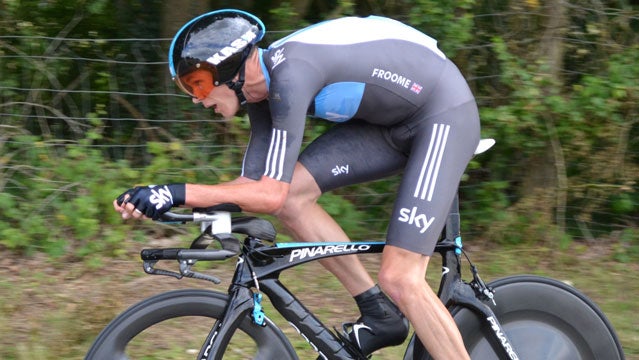On Monday, Tour de France champion Chris Froome toed the start line at Colorado’s USA Pro Cycling Challenge for a weeklong bike race through the Rockies. It's his first World Tour stage race since thrashing a field of international stars on the steep slopes of the Alps and Pyrenees.
How to Save Cycling
���ϳԹ���'s editors lay out their road map to restoring the sport's credibility.����
It's also Froome’s return to a pressroom full of hounding journalists, and an audience filled with passionate but cynical cycling fans. For as fast as Froome rides, he can’t seem to out pedal the persistent doping questions.
This was evident at a news conference on the first rest day of the Tour de France. The morning after Froome decimated the field on Mount Ventoux, reporter after reporter asked the eventual Yellow Jersey winner, How do we know for sure you’re clean? We’ve been burned before. Prove it to us.
Finally, exasperated with the inquisition, Froome’s director on Sky Pro Cycling, Dave Brailsford, the microphone.
Look, Brailsford said, “We’ve wracked our brains thinking about ways we can satisfy people and make these questions go away.”
Then, Brailsford waved his hand at the audience—at all of us, really.
“Why don’t you collectively get organized,” he said. “And you tell me what we could do, so you wouldn’t have to ask the question?”
Not longer after Brailsford posed his challenge, ���ϳԹ��� accepted. In the weeks between the end of the Tour de France and the start of the Pro Cycling Challenge, I spoke with pro cyclists, anti-doping advocates, sports scientists, and psychologists. I asked these experts, if there was a verifiable way for Chris Froome to prove to all of us he’s clean? Then, I asked myself, why should he have to?
Before we explore the outer reaches of the anti-doping universe, lets first examine the current state of the grassroots effort to clean up pro cycling: The once vaunted summit resulted in little more than holding a panel in which a three time Tour de France winner sat next to a Twitter persona. sells a fair amount of rubber bracelets but doesn’t seem to do much else. The physiologists and sports doctors who hold up pVAM (a formula that predicts climbing speeds) and estimated wattage as a golden barometer of doping suspicion have been by the people who initially developed the use of power data in cycling, like Dr. Andy Coggan. The Kimmage Fund, set up to help fight corruption within cycling’s governing body, the UCI, ended up itself.
Even David Walsh, the Sunday Times reporter who crusaded against Armstrong, has been on social-media for claiming Froome is clean. Noting the infighting consuming the anti-doping movement without Armstrong as a focal point, Bicycling magazine editor-at-large, Bill Strickland, tweeted, “I guess when the gladiators slay the lion they end up fighting each other for sport.”
Into this fray, I introduce an Australian lawyer and bike racing fanatic named Teague Czislowski, who claims he can prove an athlete is clean beyond any doubt. (Who the heck is Teague Czislowski, you ask? Who cares, I answer. This anti-doping movement is anyone’s game. It’s the Wild West.)
Czislowski’s initiative is called the , and it contains nine steps for official authentication as a clean athlete. The first five steps focus on full transparency. An athlete must sign an anti-doping contract, divulge their associations with doctors, trainers, and coaches, and offer up anything else that might help prove they’re clean—blood data, training schedules, injury history, power files, etc.
The sixth and seventh steps of Clean Protocol certification introduce novel, but not unfounded, means of assessing an athlete’s integrity. In the sixth step, the athlete undergoes a psychological test called the Performance Enhancement Attitudes Scale (PEAS). The PEAS was developed by Andrea Petroczi as part of his doctoral dissertation in 2002 and published with a colleague in 2009, and utilizes a series of open-ended questions to assess an athlete’s moral stance toward performance enhancing drug use and cheating. For example, athletes who use supplements are more likely to resort to doping.
A by the World Anti-Doping Agency on athletes who took the PEAS stated that, “Participants with higher levels of moral functioning had more negative attitudes towards PEDs.”
The next and final Clean Protocol step is deception testing. But Czislowski doesn’t rely on polygraph machines. They’re proven inaccurate. Instead, the Protocol outlines five different, cutting edge methods of catching someone in a lie, from ferretting out subconscious associations, to eye ball tracking (think, shifty eyes).
If an athlete fails the deception testing, they can still get Clean Protocol certified by signing a legally binding statement—in the U.S., that means under oath, and threat of perjury—or they can take a Functional Magnetic Resonance Imaging test, which measures blood flow to the part of our brain that manages lying. The Protocol claims the FMRI test is 97 percent accurate, but can be prohibitively expensive.
Dr. Michael Puchowicz, who has gained an online following for his mathematically based anti-doping blog, , worked with Czislowski on the Clean Protocol as a scientific advisor. “At worst, it’s��a new way of looking at the question,” Puchowicz told me. “At best, it may actually work.”
Still, it seemed that psychological and deception testing was a lot to ask of Froome, who’d done nothing to incite suspicion other than winning the world’s biggest bike races. Then, I read that Marcel Kittel, the break-out German sprinter who won four stages at this year’s Tour de France, a lie detector test to assert his dope-free purity at the request of SportBild magazine. I recalled, as well, that NFL draft prospects take the Wonderlic, a psychometric cognitive ability test.
After realizing athletes are already subjecting themselves to lie detector and psychological tests to win over fans and potential employers, I reached out to Phil Gaimon, a 27-year-old domestic pro who recently signed with one of the world’s best teams, American outfit Garmin-Sharp. Gaimon is vocal about his disdain for cheaters. His right arm is with a green bar of soap and the word: CLEAN.
“Would you take a lie detector or psychological test to prove you’re not a doper?” I asked Gaimon. “Or does it put too much onus on the athlete?”
“It’s a lot to ask,” Gaimon said. “But yeah, if I was someone like Kittel, and it was a voluntary test, that’s exactly what I what I would do.”
“But this is a terrible time to be one of the world’s best cyclists,” he added. “Because the better you perform as a racer, the more suspicion you draw.”
Next, I called Kristen Deiffenbach, a sports psychologist and professor at West Virginia University who works with USA Cycling. I asked her, “Can psychological and deception testing accurately gauge an athlete’s proclivity for PED use?”
“Not really,” she told me.
“It’s less about the individual athlete, and more about the cultural perception surrounding them,” Deiffenbach explained. Even if an athlete posted glowing scores on a battery of psychological examinations and deception tests, Deiffenbach said, it doesn’t necessarily mean they would gain any credibility in the eyes of the public.
Furthermore, Deiffenbach said, “A number of studies have shown the best values and beliefs don’t always transfer to behavior. Economic research in the business world shows people will compromise their morals when put in specific situations.” (See: U.S. Postal team, .)
The problem then, I concluded, may actually be with us, the cycling fans and journalists, not the current crop of pros, who’ve done little to earn our scorn.
Maybe we should stop asking Chris Froome to prove he’s clean, and start asking ourselves why we can’t trust him? In our effort to weed every last cheater out of the sport, we’ve started crucifying our ostensibly clean champions. In our vigilance to protect the sport we love from doping, we’re actually hurting it.
“We’re like broken hearted lovers. Our sport cheated on us, and we’re afraid to get hurt again,” I told Deiffenbach. “How do we get over that pain?” I asked.
“It takes time,” she told me. “Remember, for many modern cycling fans, Lance was their first hero. We need to vent. We need to cry.” We’ll be a bit guarded about heralding our next champion, Deiffenbach said, but we will learn to love again.
Deiffenbach hung up, and I felt a lot better about myself, and the sport. I decided that if cyclists want to voluntarily submit themselves to the Clean Protocol, that’s great. But I won’t hold them to that standard. I’ll rely on the increasingly stringent anti-doping measures already in place, and my own ever-shaky faith.
I’ll retain my professional skepticism. I’ll enjoy the gossipy quality of doping innuendo for exactly what it is—gossip. But I’ll resist rolling my eyes when a racer shreds the peloton on a vaunted climb. When Froome takes off up Colorado’s iconic Vail Pass during Friday’s time trial, it may be one of the most compelling feats of cycling ever seen on U.S. soil. And I plan on enjoying every thrilling minute.


